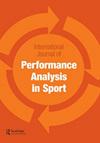2020年奥运会比赛相关表现:高水平柔道运动员技术变异性分析
IF 1.6
4区 教育学
Q1 Health Professions
International Journal of Performance Analysis in Sport
Pub Date : 2022-06-06
DOI:10.1080/24748668.2022.2084594
引用次数: 2
摘要
摘要本研究旨在通过2020年奥运会高水平柔道比赛的表现指标和技术类型来识别技战术的变化。这些数据是从官方成绩册中提取的,考虑到393名参赛者的比赛表现。分析了Nage waza katame waza和得分指数,以及根据性别、体重类别和比赛结果对技术组的分类。根据性别使用t检验来比较变量,并进行方差分析来比较权重类别和比赛结果组。最后,使用卡方检验来检验比赛中技术组和位置组的频率、重量类别和比赛结果之间的相关性。显著性水平为5%。主要结果表明,与其他组相比,奖牌获得者的nage waza和katame waza变异(绝对值)更高(p<0.001),与非奖牌获得者相比,重复赛组的数值更高(p<0.001)。女性的katame waza变异指数更高(p=0.019),奖牌获得者的得分和nage waza变异系数高于重复赛组和非金牌获得者(p<0.001)与雄性相比,武士刀的waza变异很大。本文章由计算机程序翻译,如有差异,请以英文原文为准。
Match-related performance during the Olympic Games 2020: a technical variability analysis of high-level judo athletes
ABSTRACT This study aimed to identify the technical-tactical variation through the index of performance and types of techniques in high-level judo in the 2020 Olympic Games. The data were extracted from the Official Results Books considering the competition performance of 393 competitors. Nage-waza katame-waza and scoring index, and the classification of techniques groups according to the sex, weight category and competition outcome were analysed. A t-test was used to compare the variables according to the sex and analysis of variance to compare weight categories and competition outcome groups. Finally, the Chi-square tests were used to test the association between frequency of groups of techniques and places in the competition, weight category and competition outcome. The level of significance is 5%. The main results demonstrated higher nage-waza and katame-waza variation (absolute values) for medallist compared to the other groups (p < 0.001), and higher values for repechage group compared to the non-medallist (p < 0.001). The katame-waza variation index was higher in female (p = 0.019) and medallists have a higher scoring and nage-waza variation index compared to the repechage group and non-medallist (p < 0.001). We concluded that medallist athletes have high technical variability compared to the other groups and female athletes have a high katame-waza variation compared to the male.
求助全文
通过发布文献求助,成功后即可免费获取论文全文。
去求助
来源期刊

International Journal of Performance Analysis in Sport
SPORT SCIENCES-
CiteScore
4.70
自引率
4.80%
发文量
38
审稿时长
>12 weeks
期刊介绍:
The International Journal of Performance Analysis in Sport aims to present current original research into sports performance. In so doing, the journal contributes to our general knowledge of sports performance making findings available to a wide audience of academics and practitioners.
 求助内容:
求助内容: 应助结果提醒方式:
应助结果提醒方式:


